
|
The Windhook Interview—Peg Grady |
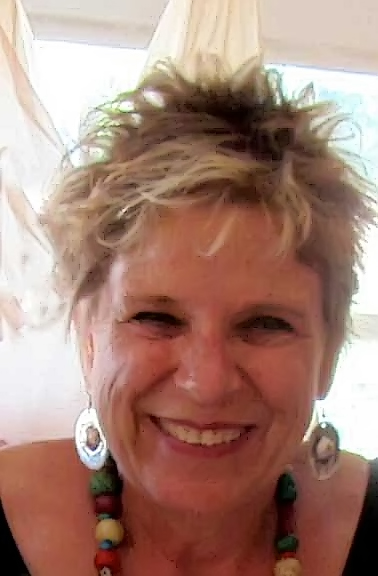 In mid-September we visited the studio and home of Peg Grady in the hills 10 miles east of Santa Margarita, CA. Peg is a painter with more than 70 shows to her credit in galleries from Maryland to California and from Arizona to Oregon. Peg is a character bigger than life, who has spent a lifetime making interesting, and sometimes surprising choices, and this adventurous streak runs right through her work. You can see more about Peg at peggradyart.com. So let's dive into the interview.
In mid-September we visited the studio and home of Peg Grady in the hills 10 miles east of Santa Margarita, CA. Peg is a painter with more than 70 shows to her credit in galleries from Maryland to California and from Arizona to Oregon. Peg is a character bigger than life, who has spent a lifetime making interesting, and sometimes surprising choices, and this adventurous streak runs right through her work. You can see more about Peg at peggradyart.com. So let's dive into the interview.
Michael: The Santa Ynez Valley News recently described your biography as “colorful.” Could you shed a little light on that?
Peg: Oh yeah, yeah, about my colorful biography—well, by the time you’re 60 years old you should have a colorful biography. Probably it’s the whole idea that I didn’t grow up, go to art school, get my MFA—you know, I didn’t do what I was supposed to do. So instead I grew up, sort of, had 500 different kinds of jobs, always did some sort of art, or some sort of craft, or something, was a prison guard, wrote horoscopes, did all sorts of very strange things that most normal people don’t do.
Michael: You started out in New York. In what ways have your early days in the City influenced you?
Peg: I was born and raised in New York City—in Queens—in an apartment building that Don says looks like something out of the Soviet Union. [Don Lampson is Peg's life partner.] It was pretty sparse, but what do you know when you’re a kid? That’s how you grow up, and that’s how you figure everybody grows up, so yeah, I grew up in Queens. When I was 20 I moved into Manhattan because that’s where the happenings were. I worked there and just did the city life. I went to clubs—this was the late ’60s and early ’70s so everything was happenin’. It’d be like which demonstration should we go to this weekend? That kind of thing.
Peggy: Did you hang out with other artists there or were there artists in your family? Anyone into art in your family?
Peg: No, no. And I was really more of a hippie then rather than an artist. To call myself an artist at that point would have been a real stretch. I was doing stuff that hippies do, but no, I was not at all serious about being an artist then. I didn’t even know that’s what I was. It’s just kind of a surprise.
Michael: How would you say that that time has impacted you as an artist and creative person?
 Peg: Probably just the freedom of the time—the whole idea that you could just do whatever you wanted to do. You could be whatever you wanted to be. The whole feminist movement came in then and prior to that you could be a secretary or a teacher or a nurse, and you’re supposed to be a good little girl, and blah blah blah. Then feminism and the whole antiwar movement and—it just went nuts—and it just blew everything up, so how could you not be impacted. It was that whole sense that you could just do whatever the fuck you want. I don’t think you can be an artist without that feeling. In 1968 I was 18, so it was the most impressionable time of becoming a person, and it was just when the whole world was going wild.
Peg: Probably just the freedom of the time—the whole idea that you could just do whatever you wanted to do. You could be whatever you wanted to be. The whole feminist movement came in then and prior to that you could be a secretary or a teacher or a nurse, and you’re supposed to be a good little girl, and blah blah blah. Then feminism and the whole antiwar movement and—it just went nuts—and it just blew everything up, so how could you not be impacted. It was that whole sense that you could just do whatever the fuck you want. I don’t think you can be an artist without that feeling. In 1968 I was 18, so it was the most impressionable time of becoming a person, and it was just when the whole world was going wild.
Michael: And you were 25 when you moved to California?
Peg: Yeah, I did something stupid and married some guy who I shouldn’t have married. And one of the good things was he had been out in California when he was in college and he said, “You want to move the California?” So that’s what we did. I was 25. We moved to LA. If we had moved from New York to here I would have lost my mind! It even was strange going from the energy of New York to LA. LA was so laid back in comparison that it took a long time to get—LA was very strange, very strange.
So anyway, I moved to LA and then I divorced the fool, and a long ugly story we won’t go into. Then I met Don in LA. We were both working for the Herald Examiner newspaper. We were both selling advertising.
Michael: How long ago was that?
Peg: 1979. Why? Did you work there?
Michael: No, just wondered how long you two have been together?
Peg: 30 years.
Michael: So you worked at all these different jobs.
Peg: I worked at all these different jobs for many years.
Michael: And when you were 40 you went back to school?
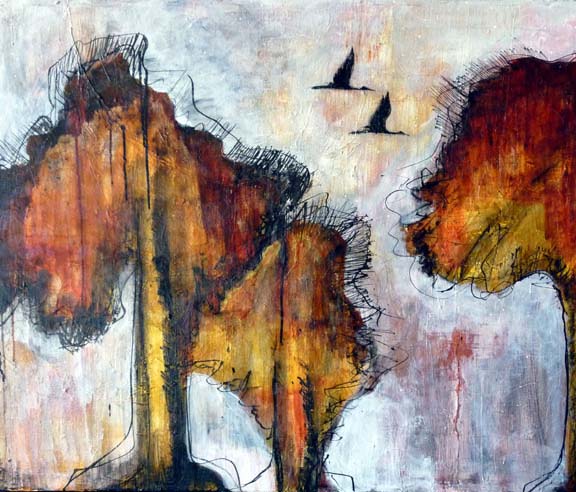 Peg: Yeah basically. I was always wanting to make stuff. Again to call it art would be a stretch but I always liked making things. And I was searching for something to do and I thought I’d like to learn to paint ’cause that just seemed like that’s what you’re supposed to do. You know you’re supposed to learn how to paint. So I took a class. It was just an adult education class and it was a watercolor class and it was the most God awful boring horrible class I’d ever been in. But I stuck with it. I knew this wasn’t what I wanted to do but I really wanted to see where it would go, and I saw an article in the Tribune that there was going to be a workshop given by Bob Burridge, and I think it was called “Get Loose and Juicy” or something. I asked the teacher of this horrible watercolor class about it, “Do you think I should do this? Do you think I’d like it?” and he said “yeah, I’m sure you would really like this class.”
Peg: Yeah basically. I was always wanting to make stuff. Again to call it art would be a stretch but I always liked making things. And I was searching for something to do and I thought I’d like to learn to paint ’cause that just seemed like that’s what you’re supposed to do. You know you’re supposed to learn how to paint. So I took a class. It was just an adult education class and it was a watercolor class and it was the most God awful boring horrible class I’d ever been in. But I stuck with it. I knew this wasn’t what I wanted to do but I really wanted to see where it would go, and I saw an article in the Tribune that there was going to be a workshop given by Bob Burridge, and I think it was called “Get Loose and Juicy” or something. I asked the teacher of this horrible watercolor class about it, “Do you think I should do this? Do you think I’d like it?” and he said “yeah, I’m sure you would really like this class.”
So it was given over at Cuesta College. I guess it was ‘88 or ‘89. It was on a Saturday and I was working at the prison and had to work weekends, so of course I called in sick and went to this class. I had brought my paper and my paints and everything, and in comes Bob and he’s got a boombox blasting and he’s like a wild man, and he’s like “all right! we’re gonna paint!!!” I'd found it! He’s a fabulous workshop instructor. He’s the kind of person who, even if you don’t know what the hell you’re doing, he can bring it out in you, and he’s just wild and crazy and that’s what started it really. That’s what started this part of my life pretty much, and I’d have to give him the credit or blame for doing that. And it was just—there was just something about his teaching method, his enthusiasm, that just got into me. He says he gives you permission to do what you want to do. So he was very, very good.
So I went back to Cuesta. I didn’t get an MFA and all that kind of stuff, and I took a lot of art classes. Everything from just basic 2-D design. I took sculpture, life drawing, everything. They finally just kind of threw me out because I finally ran out of classes that I could take.
Michael: Let’s talk about motivation and the challenges of keeping yourself going. Is that ever an issue for you? Do you ever hit dry spells? Ever get to point where you just can’t seem to make it happen.
Peg: Oh yeah! I cry, and rant and rave and bitch and moan. I guess I’m old enough to know that no process is gonna be smooth the whole way, and to just grit your teeth and just keep going. ’Cause when I do so many different things, a lot of times if I get stuck it’s because I’m getting bored with the process I’m doing right then. So I'll switch over. That helps a lot. A lot of times it’s just a matter of changing materials. But again, I always think that you’re supposed to be a painter. That’s the rule, you’re supposed to be a painter. You know I have no idea where that came from but it’s in my head. And so a lot of times I’m painting and I’m finding eewww, yuuckk! And what I really want to do is to smash things and staple things and glue. So it helps a lot to jump from one material to another. And then what I’ve found real helpful for me to keep going is something I call "daily discards". You know, real simple line drawings every day—forcing myself to do something really simple every day. Really, it gets a momentum going. so now I’m doing a new thing. It’s a weekly thing, but again, it’s giving myself an assignment. And what’s good about that too, is that then “I’ve done my work” and then I’m free to go do something experimental—I can play. That helps.
Michael: How much do you structure your time? Some people are in the studio every morning and work X number of hours no matter what.
Peg: It’s not like that. I’m a creature of habit. I’m usually up before the sun and I’m out the door as soon as I can, and I go for a 4 mile run-walk type of thing and that’s where I clean my head out. I work on a painting or an idea when I’m walking. So then I might rush to the studio because it’s such a genius idea I don’t want to lose it, or I may have come up with like zilch, so then sometimes I just screw up and sit around and look at the internet and “research”.
Peggy: So your "daily discards"—did you have a set time? Did you do them first thing in the morning and how long did they take you to do?
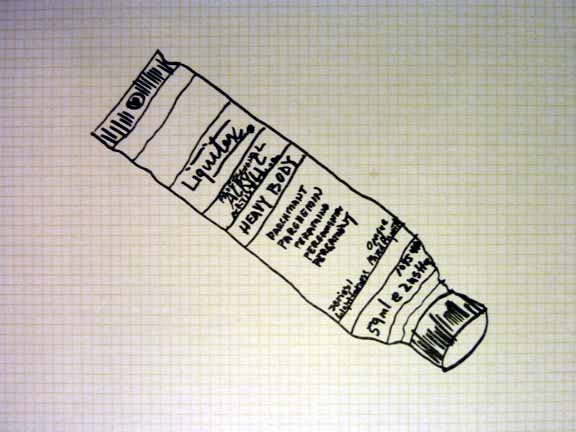 Peg: No, just whenever. Sometimes it was quick—like one time it was a simple lightbulb, and then one was like an old telephone so it was one of those days I just wanted to get into doing a bunch of details, so I’m doing each little button. So it varied, but it was my assignment for the day. I just had to do it sometime during the day, and I could decide whether I wanted to do something that was really intricate or just super simple. And I really like the whole recycled idea, so I did it on recycled paper, and then I did it on old vintage fabrics and framed them in old vintage frames. So that was fun. But it gave me the freedom to then do other stuff because I’d done my homework. Can you tell I’m German?
Peg: No, just whenever. Sometimes it was quick—like one time it was a simple lightbulb, and then one was like an old telephone so it was one of those days I just wanted to get into doing a bunch of details, so I’m doing each little button. So it varied, but it was my assignment for the day. I just had to do it sometime during the day, and I could decide whether I wanted to do something that was really intricate or just super simple. And I really like the whole recycled idea, so I did it on recycled paper, and then I did it on old vintage fabrics and framed them in old vintage frames. So that was fun. But it gave me the freedom to then do other stuff because I’d done my homework. Can you tell I’m German?
So now I’m doing a weekly thing, and I just started it last week. I get the Sunday NY Times and I just take a half sheet of watercolor paper and I put the headline or the banner up there or just what interests me, and then kind of paint over it and then through the week it’s like a diary—a journal. “What did I do this week?” I’ve discovered this stuff. It’s clear gesso and I didn’t know it existed. So when I put the newspaper down—I was thinking I wanted to do it with the newspaper, especially so it had the date—so if you seal it with the clear gesso, and you can paint it, and scrape—it’s my wonderful stuff. It’s my new secret stuff. Not a secret now obviously, the whole world is going to know now.
Michael: We counted more than 70 exhibits listed on your web site since 1998. Many of them are in the Central Coast area but there are quite a few like shows in Baltimore, Scottsdale, Portland and Southern California. That’s a pretty impressive list. How did you manage to make that happen? Did you start showing in 1998 or is that just where you started listing shows in your resume?
Peg: Really? And that’s edited. Well I’ve been in group shows. The ones in Baltimore—this was years ago. Of course this was when the economy was a hell of a lot better than now, and basically I was just researching galleries that handled work similar to mine throughout the country. So I sent out letters of inquiry—cold calls, basically. But this was email so when they hang up on you you don’t know—the feeling of rejection wasn’t quite as severe. And this gallery in Baltimore contacted me and said, “Hey, we like your stuff,” and you know, I’ve never been there. I never actually saw the gallery. I was surprised, but he sold work of mine. What was amazing was—this is weird. You’re 3000 miles away, and he gave me the names of about three other artists who he had represented, and I contacted them and they said “He’s cool, he pays on time, he doesn’t screw with you, he handles your work really well, and I never had any problem whatsoever.” And a couple of years later he decided to retire. He actually moved to Colorado to open a restaurant. He sold it to a gal who’d been working for him for 11 years, and then finally the times just ate her up.
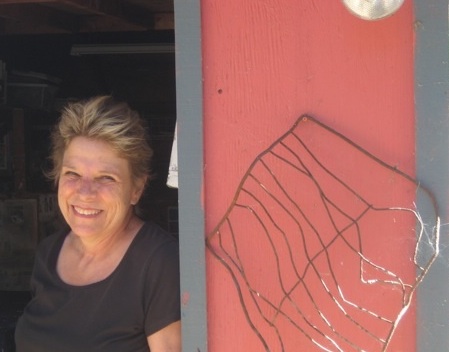 And then the gallery in Portland—the Beet Gallery—they just had a call out for fiber art and I had done some fiber arts, embroidery and stuff, and I contacted them. It's mostly through the internet, seeing the calls for art that are out there. A lot of the galleries I listed are shows that traveled—some prints that traveled.
And then the gallery in Portland—the Beet Gallery—they just had a call out for fiber art and I had done some fiber arts, embroidery and stuff, and I contacted them. It's mostly through the internet, seeing the calls for art that are out there. A lot of the galleries I listed are shows that traveled—some prints that traveled.
The C Gallery in Los Alamos—my friend Julia Alexis told me, “Peg you have to go and see this gallery because it’s really cool.” So I went online and looked, but the gallery doesn’t have one of those automatic email sign ups, and you have to email her and ask her to put you on her email list. So I just dropped her an email and on the bottom of my email is my website. And about 6 weeks later she contacted me and said, “I really like your work.” I wasn’t pitching her. I just wanted to be on her email list. So I went down there and brought some pieces down with me and I’m thinking she probably has a group show. But she says, “When would you like a show?” So it was about a year later. It was one of those things. You bust your ass trying to go around pitching, schmoozing and all that kind of crap, and then you just send an email, not even trying, and there it is.
Peggy: Are there particular groups—you mentioned the Fiber Arts group—are there other groups or websites you check regularly for Calls for Art?
Peg: The Fiber Arts is really good because they have a website they update really frequently. It’s fiber arts, but a lot of times it’s a group show and they let all kinds of art in. I use Google Alerts and have an alert for “Call for Art,” and a lot of times there’ll be galleries that’ll be having something. Of course a lot of it, 90%, is just places trying to make a buck with their entry fees, and that’s unfortunate. And I check into the local stuff, I’m hooked in, and you know—it’s a struggle.
Michael: We did a quick Google search and found over 860,000 references to Peg Grady. The first nine pages only had a couple links that were not about you. You clearly have an internet presence. To what extent do you manage that?
Peg: No, anytime I do something right, it’s an accident. No I research. It’s probably the local papers and stuff. I’m impressed too. You just punched in Peg Grady and that’s what you got?
Michael: You’re pretty well known in this area.
Peg: Well, yeah I’ve been around here a long time. Like the show in Cambria, the Deer Run—Nick found me. I mean I knew him to say hi at shows and stuff but that was about the extent of our relationship. Nick Wilkinson, he is like the curator for Deer Run. He was doing art shows—he found it because I put DailyDiscards on Facebook. And he really liked them. I use Facebook. I don’t like to promote myself a lot but if I’m doing something fun I’ll throw it on there—researching on the internet, looking for shows that are looking for people.
<---- Beginning of inset panel block ---->
<---- Beginning of inset panel block ---->
<---- Beginning of inset panel block ---->
|
Peggy: Where have you found that you do sell?
Peg: In the Baltimore gallery I felt happy with the number of sales, it wouldn’t have blown anybody else’s socks off, but I was quite happy with that. So the East Coast sells well.
I sold real well in Cambria in the Deer Run, I sold seven of the stitching and three of the drawings. It’s all very hit and miss. I have people around who are collectors who actually like my stuff and like to add pieces every once in awhile, and I have a couple of wealthy friends, which helps a lot that they can actually afford to buy things. I’m not earning a living with my art, and of course times are so bad right now and I’m always looking for a gallery that would take me on as one of their artists, but I think right now it’s futile—they’re struggling— to barely stay alive, you know.
|
|
<---- End of inset panel block ---->
Michael: Anything else you want to say about your marketing strategy?
Peg: I guess I go on the Internet a lot and look for calls for art. Like the one in Tucson was basically he just had a call out and it was a funky fun wonderful gallery and it gave me an excuse to call my buddy Paula up and say, “Hey, you want to go to Tucson for the weekend? We have an opening, so let’s show up there?” So my marketing strategy is just hit and miss. I’m not much of a business person.
Michael: Well this is a problem most artists struggle with.
Peg: And that’s why you need someone like a Ronda. You need Ronda or Kate Burridge. [Editor’s note: Ronda LeBrane and Kate Burridge are the spouses of San Luis Obispo artists Larry LeBrane and Bob Burridge. Ronda and Kate are both well known locally as effective promoters for their respective spouse’s work.]
Michael: How do you see local art associations or groups contributing to your success and development as an artist? How does it work for you?
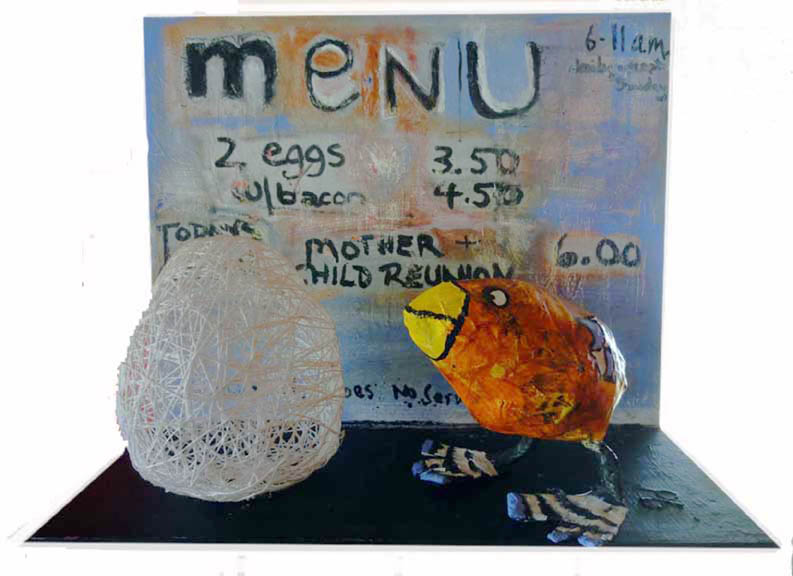 Peg: Paso Robles Art Association is one, then the San Luis Obispo Museum of Art, then I used to be in OPAG. I think the value of the local groups is first of all just having the camaraderie of other artists. That’s one of the things about Studios on the Park let’s say, you guys would bop in, there’d be other artists around. That part is good. Because being an artist is a fairly solitary pursuit and having an organization is good, so just having other artists around to bitch and moan to and you get to know where shows are, what’s going on, who’s going where and now of course Facebook has taken a lot of that on: Posts about local shows—but the artists groups are a good way of marketing and networking and you meet other artists, so you have other people to hang out with and you find your tribe that way. And that’s hard because artists are isolated so you have to come together somehow. We don’t have the Cedar Tavern to hang out with, and get drunk with all the other abstract artists and argue. So it’s good for that.
Peg: Paso Robles Art Association is one, then the San Luis Obispo Museum of Art, then I used to be in OPAG. I think the value of the local groups is first of all just having the camaraderie of other artists. That’s one of the things about Studios on the Park let’s say, you guys would bop in, there’d be other artists around. That part is good. Because being an artist is a fairly solitary pursuit and having an organization is good, so just having other artists around to bitch and moan to and you get to know where shows are, what’s going on, who’s going where and now of course Facebook has taken a lot of that on: Posts about local shows—but the artists groups are a good way of marketing and networking and you meet other artists, so you have other people to hang out with and you find your tribe that way. And that’s hard because artists are isolated so you have to come together somehow. We don’t have the Cedar Tavern to hang out with, and get drunk with all the other abstract artists and argue. So it’s good for that.
Michael: That’s a very important point, community is something artists struggle with a lot.
Peggy: Do you or did you have mentors, other than Bob Burridge?
Peg: Bob put me on the road, and I still think of him really highly and I like his work. Yes, my friends, Sarah Winkler and Henry Ramos. We would get together once a month, bring our work and critique each other. And I belong to a group with Julie Frankel and other people and we meet once a month and critique. There’s no one in particular pushing me, because I think if you’re not in school, like from what I understand people who go to school the proper way, once they get out they feel really lost—they lost their structure. Again, I have artists groups, informal and formal. And even though Sarah’s moved up to Berkeley we get on the phone—I can send her a photo of it—this sucks, it’s horrible—and with internet you can do that throughout the world. Although it is great to get together.
Michael: Before we started, you joked about not having an adult in the family. So I wanted to ask you what’s your take? What’s your perspective on having two artists in the same household?
Peg: Oh, I think It’s great—and who needs an adult? Peter Pan and Wendy is just fine! I think 2 artists living together is great because you don’t have to explain yourself. If I’m just sitting here and all of a sudden I zone out, Don doesn’t take it personally like I’m ignoring him. He knows I’m thinking, “What the fuck am I going to do with that thing I’m working on?” And it’s the same thing with him. He’ll be in the living room plunking away on his guitar ’cause he’s writing a song, and growl, “grrrr! no that doesn’t work.” Yeah, I mean it’s who you should be with. I don’t see how you can be with someone who doesn’t have that weird creative push. You know it doesn’t matter in what direction, just something. And you don’t need an adult. But it would be nice sometimes if someone would do something they’re supposed to. I’m kind of the somewhat organized person who does take care of the bills but it’s real hit or miss. That person doesn’t live here.
Michael: Do you have any regrets?
Peg: Oh yeah, I wish I had started this way, way, way sooner. If there was any regret, I mean that would be it. I wish I had realized that you don’t have to be Michelangelo to be an artist. But other than that, no. Well I wish I had been born to really rich parents. That would be nice, but for anything I had any control over, that would be my only regret—that I had waited—just such a late bloomer to actually throw myself into it.
Peggy: How did you transition out of the work world?
Peg: I started seriously doing art to where I thought, yes I’m an artist, when I was 40, so I was working at the prison. It was the only thing keeping me sane working at the prison. It was such a negative, negative place to be, and you needed to get out of that head. And it’s probably similar to meditation in a way, where you’re just all of a sudden—that other stuff is just gone and you’re not thinking anymore. So I started at 40, and for ten years I was working and painting and making things and the second I hit 50 which is the earliest you could retire—I mean you get a shitty pension, but so what—it was freedom. So I was working and being a painter.
Michael: This touches how most people have to address the question, “How am I going to pay the bills?” Most artists don’t pay their bills with their art. So having a strategy to figure out an income to keep you afloat while you’re doing art is challenging.
Peg: It is. It’s very challenging. There’s like two ways to go. You can either do art related things or you can do something totally not art related and that’s what I did. And that would be my recommendation to anyone. I think because I’ve seen people who do teaching or they do framing or they do something that’s art related and I think it just sucks the creativity out of you. It can be horrible, like sometimes when I was working at the prison, I was working the graveyard shift and I would come back and go into the studio. When you’re sleeping during the days and working at night, your brain just doesn’t function right. But it was still better than if I was doing something art related and then coming home and being tired of the art related stuff.
Peggy: So what inspires you?
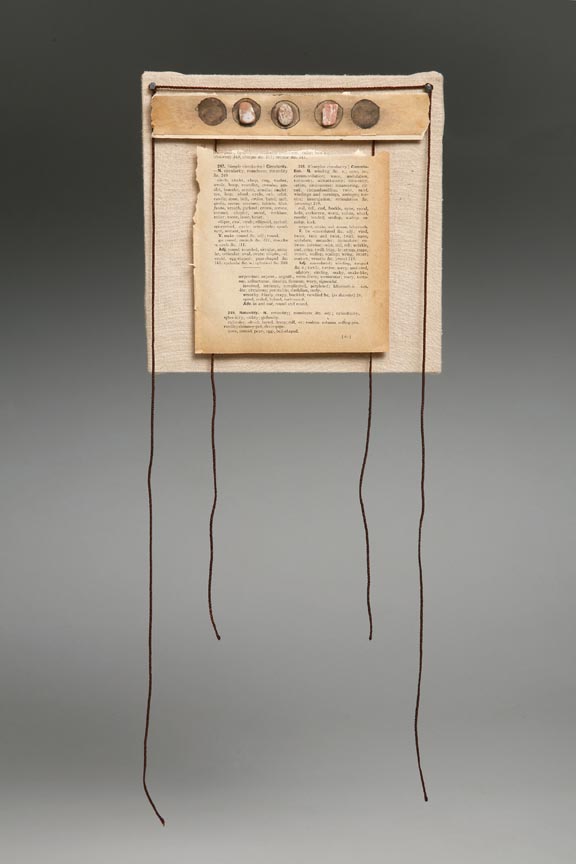 Peg: I knew you were going to ask that. Mostly what inspires me are materials. It’s like this little series here. [Points to a collection on the wall.] it’s from an old Thesaurus. I like old stuff. I mean a lot of times, that’s what will get me going. I really like doing those assemblages, so I like going to thrift shops and finding junk. A lot of times I just look at something and think, “That looks cool” and who knows how your brain actually works. And because I use a lot of different materials, I’m always looking in magazines and books, and so I draw from a lot of different things, it’s not like if I was strictly a painter and I would just be looking at paintings. I draw from so many different types of creative things, like sewing, sculpture, just all sorts of things, so it just all kind of boils around and I always have bunches of bird nests and stuff. And it’s interesting, they wind up in the paintings too, and then a lot of times I say, “Oh look at that! There’s bees in like 6 of my paintings,” and I have no idea where it comes from. Who knows? I don’t know.
Peg: I knew you were going to ask that. Mostly what inspires me are materials. It’s like this little series here. [Points to a collection on the wall.] it’s from an old Thesaurus. I like old stuff. I mean a lot of times, that’s what will get me going. I really like doing those assemblages, so I like going to thrift shops and finding junk. A lot of times I just look at something and think, “That looks cool” and who knows how your brain actually works. And because I use a lot of different materials, I’m always looking in magazines and books, and so I draw from a lot of different things, it’s not like if I was strictly a painter and I would just be looking at paintings. I draw from so many different types of creative things, like sewing, sculpture, just all sorts of things, so it just all kind of boils around and I always have bunches of bird nests and stuff. And it’s interesting, they wind up in the paintings too, and then a lot of times I say, “Oh look at that! There’s bees in like 6 of my paintings,” and I have no idea where it comes from. Who knows? I don’t know.
Michael: Let’s imagine that there’s a person sitting with us who is just beginning to realize they want to embark on a creative life -- what would you tell them?
Peg: I would tell them not to listen to anything anybody says, including me. Basically I think that the thing that stops people is that they think there’s a certain way they’re supposed to do things, and if they don’t fit into that way they think that they’re not an artist or a dancer or whatever it might be. And I think the biggest block is that, and that’s what they have to ignore and just listen to yourself. And it’s hard when you’re first starting out because you don’t know what yourself is. So it’s kind of like you have to stay loose enough and not, you know, when you see those blocks coming—“oh I’m not supposed to”—just knock it off! That’s what I would tell them. And also live within your means. Don’t get yourself into debt. You can live without a lot. Don’t fuck your life up because you think you need stuff. I mean you need food and a t-shirt but you don’t need all that other crap and you certainly don’t want to give up your real life for it. So live within your means and don’t listen to what anyone else says.
The creative life is just such a good way of spending our time on earth. It’s just really—I don’t know how people who don’t do it get by. I look at my mom and she’s 90 years old and if you’re lucky enough to get to be 90, you’re going to be kind of arthritic and all that, and I think if I got to 90 and in not too terrible a shape, I think I’d still be doing stuff and I think that’s the joy of it. You don’t retire from being an artist. It’s just what you are. It just makes for a fulfilling life. It’s like Beatrice Wood, the potter down in Ojai—when she was almost 100—when pottery just got to be too much for her hands—her strength and her arthritis and the clay—it’s cold and wet—so she went back to using colored pencils, because that’s how she started off. So at 100 she had to modify it, which is understandable. And I don’t know what you do if you don’t do that. I don’t know what fills your soul with happiness. I mean what would you do if you weren’t an artist?
Michael: I did that for awhile and it didn’t work.
Peggy: The bad news, bad economy, you always still have the art. Nobody can take the art away.
Peg: Even when I worked in the prison, even the prisoners who were artists in the prison had something. They were doing something. I mean they didn’t have all the equipment and stuff, but they had something to turn to. A lot of it was very much like tattoo art, but they had something to do other than just be jerks. You could see that they appreciated the fact that they could do that kind of stuff. Because you get out of your head. You turn off the news. Someone pisses you off, you just take your hammer and beat shit apart. And usually I’m out in the studio blasting some music, It’s just good. It’s just good. Like I said, I wish I had just started earlier.
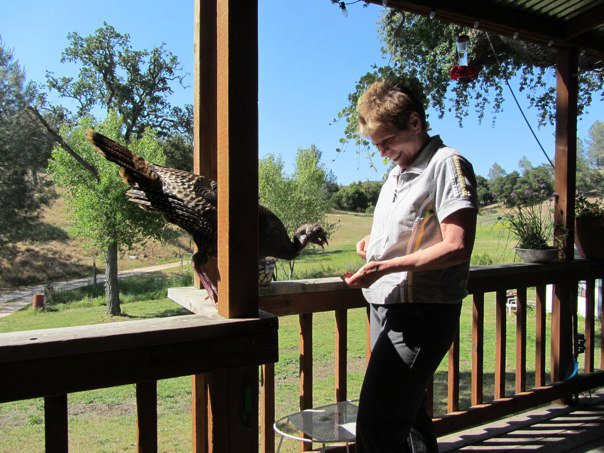
|
Return to the OTL archive list
|
|
Copyright © 2011 Windhook. All Rights Reserved. |
| | 
